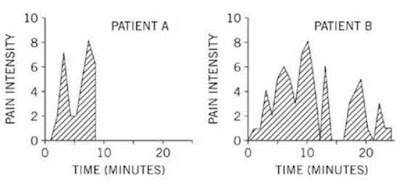Illogical Memories of Pain
One of the
surprising things I learnt from Daniel Kahneman’s book, Thinking, Fast and Slow, was about how we humans remember pain.
Researchers studied a bunch of patients undergoing a painful procedure and
asked them at 1 minute intervals to rate the intensity of the pain (0=lowest;
10=highest). Here is how the graphs
looked for 2 patients:
Notice that
Patient A’s procedure lasted 8 minutes while Patient B’s lasted 24 minutes. So
if you asked both patients to rate the total pain they experience, you’d assume
B’s memory of the experience should be worse than A’s.
But the actual
answers received were that A’s memory was much worse than B’s, in fact on an
average twice as much! Why is that?
Researchers found a pattern that explains why:
1) Peak-end rule: Total pain is best predicted by the
average of the worst moment and the last moment (the rest of the data points
can be ignored!)
2) Duration neglect: The total duration of the experience
has almost no effect on the memory of the experience!
Other versions
of this study (not involving medical procedures) have yielded the same pattern;
so these findings are not a freak or limited to a few fields only.
This feels so
counter-intuitive, right? Shouldn’t total pain be equal to “area under the
curve”? I guess we humans are so bad at integral calculus that we can’t apply
it anywhere, neither inside nor outside the classroom!

Comments
Post a Comment